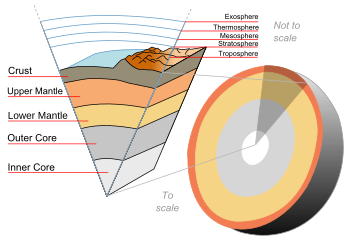Asthenosphere: Difference between revisions
m Reverted edits by 169.139.224.102 to last revision by ClueBot (HG) |
Dragoneye776 (talk | contribs) |
||
| Line 8: | Line 8: | ||
Under the thin [[ocean]]ic plates the asthenosphere is usually much closer to the seafloor surface, and at [[mid-ocean ridge]]s it rises to within a few kilometers of the ocean floor. |
Under the thin [[ocean]]ic plates the asthenosphere is usually much closer to the seafloor surface, and at [[mid-ocean ridge]]s it rises to within a few kilometers of the ocean floor. |
||
The upper part of the asthenosphere is believed to be the zone upon which the great rigid and brittle lithospheric [[tectonic plate|plates of the Earth's crust]] move about. Due to the [[temperature]] and [[pressure]] conditions in the asthenosphere, [[Rock (geology)|rock]] becomes ductile, moving at rates of deformation measured in cm/yr over lineal distances eventually measuring thousands of kilometers. In this way, it flows like a [[convection]] current, radiating heat outward from the Earth's interior. Above the asthenosphere, at the same rate of deformation, rock behaves elastically and, being brittle, can break, causing [[Fault (geology)|faults]]. The rigid lithosphere is thought to "float" or move about on the slowly flowing asthenosphere, creating the movement of [[Tectonic plate|crustal plates]]. |
The upper part of the asthenosphere is believed to be the zone upon which the great rigid and brittle lithospheric [[tectonic plate|plates of the Earth's crust]] move about. Due to the [[temperature]] and [[pressure]] conditions in the asthenosphere, [[Rock (geology)|rock]] becomes [[ductile]], moving at rates of deformation measured in cm/yr over lineal distances eventually measuring thousands of kilometers. In this way, it flows like a [[convection]] current, radiating heat outward from the Earth's interior. Above the asthenosphere, at the same rate of deformation, rock behaves elastically and, being brittle, can break, causing [[Fault (geology)|faults]]. The rigid lithosphere is thought to "float" or move about on the slowly flowing asthenosphere, creating the movement of [[Tectonic plate|crustal plates]]. |
||
== Historical == |
== Historical == |
||
Revision as of 23:02, 14 February 2010
This section includes a list of general references, but it lacks sufficient corresponding inline citations. (March 2009) |

The asthenosphere (from Greek asthenēs 'weak' + sphere) is the highly viscous mechanically weak ductily-deforming region of the upper mantle of the Earth. It lies below the lithosphere, at depths between 100 and 200 km (~ 62 and 124 miles) below the surface, but perhaps extending as deep as 400 km (~ 249 miles).
Characteristics
The asthenosphere is a portion of the upper mantle just below the lithosphere that is involved in plate movements and isostatic adjustments. In spite of its heat, pressures keep it plastic, and it has a relatively low density. Seismic waves pass relatively slowly through the asthenosphere, compared to the overlying lithospheric mantle, thus it has been called the low-velocity zone. This was the observation that originally alerted seismologists to its presence and gave some information about its physical properties, as the speed of seismic waves decreases with decreasing rigidity.
Under the thin oceanic plates the asthenosphere is usually much closer to the seafloor surface, and at mid-ocean ridges it rises to within a few kilometers of the ocean floor.
The upper part of the asthenosphere is believed to be the zone upon which the great rigid and brittle lithospheric plates of the Earth's crust move about. Due to the temperature and pressure conditions in the asthenosphere, rock becomes ductile, moving at rates of deformation measured in cm/yr over lineal distances eventually measuring thousands of kilometers. In this way, it flows like a convection current, radiating heat outward from the Earth's interior. Above the asthenosphere, at the same rate of deformation, rock behaves elastically and, being brittle, can break, causing faults. The rigid lithosphere is thought to "float" or move about on the slowly flowing asthenosphere, creating the movement of crustal plates.
Historical
Although its presence was suspected as early as 1926, the worldwide occurrence of the asthenosphere was confirmed by analyses of earthquake waves from the Great Chilean Earthquake of May 22, 1960.
References
- Donald L. Turcotte and Gerald Schubert. Geodynamics, 2nd ed., Cambridge University Press 2001
- GEMS Institute of higher education,Nepal.Environment Management Club, Kushal
- An Introduction to the Solar System; McBride and Gilmour; Cambridge University Press 2004
External links
.
